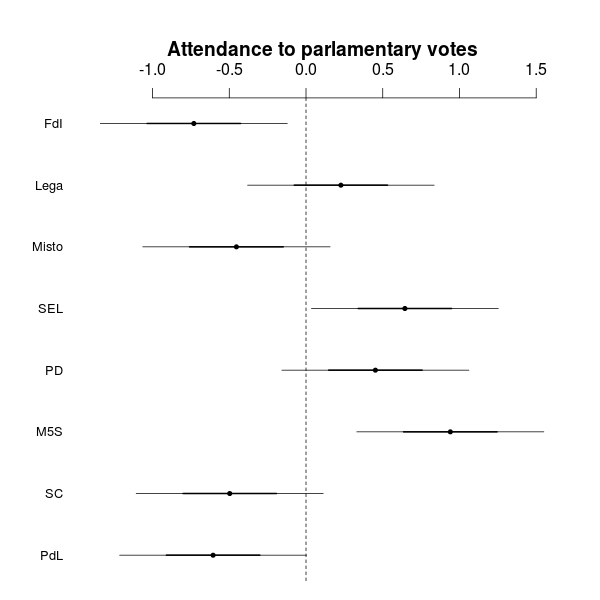Attendance in parliament (in Italy)
Earlier today, I found some interesting data on Italian MPs voting records in the current parliament (which was opened last April). The data are available for both Houses (the Italian system has a lower house, called Camera \(-\) effectively the same as the House of Commons in the UK \(-\) and an upper house, the Senate). The Camera is made by 630 MPs, while there are “only” 321 senators (some of whom are appointed for life by the President of the Republic). For each MP, data are recorded on their political affiliation, constituency, number of votes attended and total number of votes in the current parliament. I thought I tried some relatively simple model to see whether there are some substantial differences in terms of party or constituency.
I think the two houses can be modelled separately, at least as a first approximation. So, for example, say I concentrate on the lower House and define \(y_i \sim \mbox{Binomial}(\pi_i,n_i)\) where for \(i=1,\ldots,630\), \(y_i\) is the number of recorded attended votes, \(n_i\) is the total number of votes and \(\pi_i\) is the individual probability of attendance. [NB: not all MPs are “exposed” to the same number of votes, as some have been appointed after by-elections, ie after parliament was opened last April. Also, the system does not record the reason for absence and so some of them may be legitimate (eg illness, or due to other institutional engagements). Nevertheless, the data give some good indication of the actual activity of the MPs].
I used a very simple model to define the attendance probability \[ \mbox{logit}(\pi_i) = \alpha + \beta_{p_i} + \gamma_{c_i}\]where the index \(p_i\) indicates the party to which the \(i-\)th MP is affiliated and the index \(c_i\) indicate their constituency. Of course, parties and constituencies will be replicated within the dataset (because MPs cluster within them). Also, other individual- or party- or constituency-specific variables may be relevant to explain away the different attitudes to participating to the parliamentary work \(-\) but I’ll keep the model simple, mainly because I’m a bit lazy and am not spending time to find these other variables!
The model is completed specifying vague prior for the overall average attendance rate (on the logit scale), \(\alpha\) and structured priors for \(\beta_j \sim \mbox{Normal}(0,\tau_p)\) and \(\gamma_k \sim \mbox{Normal}(0,\tau_c)\), with \(\sigma_p = \frac{1}{\sqrt{\tau_p}} \sim \mbox{Uniform}(0,10)\) and \(\sigma_c = \frac{1}{\sqrt{\tau_c}} \sim \mbox{Uniform}(0,10)\).
With this specification, the coefficients \(\beta_j\) define the incremental effect of the \(j=1,\ldots,N_p\) parties and \(\gamma_k\) is the incremental effect of the \(k=1,\ldots,N_c\) constituencies on the propensity of each MP to attend the votes. Negative values for the coefficients means that a given party/constituency decrease the chance of attendance.
I ran this model and here’re the results, in the form of coefficient plots, reporting the posterior interval estimation for the effects \(\beta\) and \(\gamma\). For the Camera, the MPs affiliated with the “Movimento 5 Stelle” party and those with “Sinistra Ecologia Libertà” show positive propensity to participate in votes, while FdI (“Fratelli d’Italia”) and PdL (“Popolo delle Libertà”, Berlusconi’s party) are substantially associated with negative propensity to attend.

Constituency also seem to have some differential effect; MPs from Valle d’Aosta, Liguria, Sardinia, Friuli Venezia Giulia, some provinces in Lombardia (but not including that of Milan) and some provinces in Sicily (including Palermo) have positive propensity to attend the votes.

In the senate, the situation is kind-of-different, if only for the fact that by the nature of the Italian system, some parties are not even the same. All the “positive” party effects disappear and no party is significantly associated with higher propensity of attendance. However, “PdL” and “Scelta Civica” (the party of former Prime Minister, Mario Monti) do show substantially negative values, indicating their senators have a lower propensity to show up at parliamentary votes.
